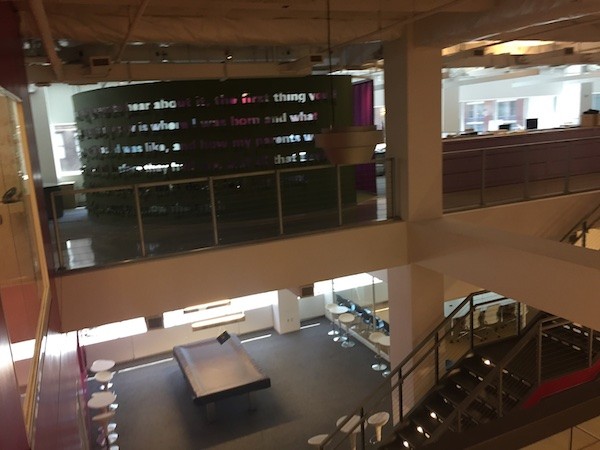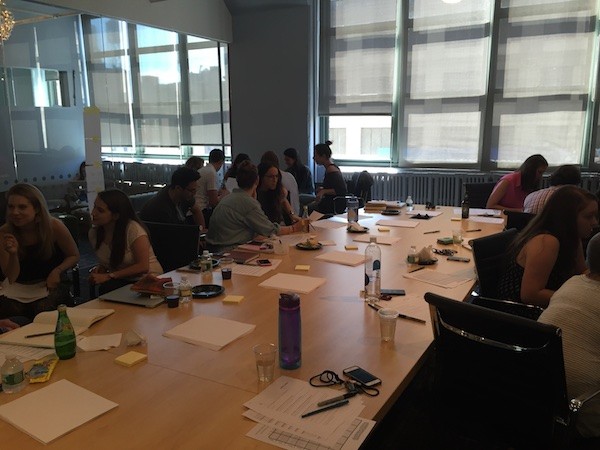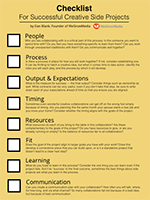This month I have worked on two side projects for large creative agencies in New York City. Today I want to reflect on:
- The value of working on side projects.
- What I learned from these creative professionals in the process.
The companies were:
- J. Walter Thompson: Founded in 1864, with a rich history in advertising and marketing communications. They created the iconic “I Wish I Were an Oscar Mayer Wiener” jingle. You can see their entire (amazing) history here.
- Kirshenbaum Bond Senecal + Partners: A creative agency working with incredible brands on advertising, marketing and branding, including BMW, Nike, and many others.
Now, I typically sign non-disclosure agreements when I do work like this, so I’m going to say ZERO about the nature of the projects I worked on. I absolutely value the privacy of the organizations I work with, and how that relates to proprietary value for each firm. But here is a peek inside each. First, the offices of J. Walter Thompson:

And this is a group activity I helped organize at Kirshenbaum Bond Senecal + Partners:

Even speaking generally, there are a lot of powerful takeaways, so let’s dig in…
Pushing Myself Outside of My Comfort Zone
WeGrowMedia is now five years old, and as a small team, we have a lot of freedom. When I take on a project with another organization, especially an agency with tight deadlines, a large staff, and firmly established processes, it forces me to work as they work.
This. Is. Good.
(In moderation, of course.)
My tone in working with them is the same as any client: understand their needs, identify the value I can bring, then deliver on that promise.
But jumping into a short term project such as these means that I may be learning the process as I go through it; meeting team members as I need to be delivering material to them; finding the right tone for every communication while others look over my shoulder.
I’m constantly looking for cues to understand the culture, and ensure I meet expectations. Well, let’s face it, I’m trying to exceed expectations.
Collaboration is Thrilling
Collaborating on short-term projects is the career version of dating. You are excited at new ideas, everyone is trying to impress and on their best behavior, and new possibilities are everywhere.
In my day-to-day work, the processes are often controlled in-house by me, Diane and Leah. The collaborations are often one-on-one. When I take on a side project, though, it is different because I am aligning to other people’s processes. It allows me to consider new ways of working, and it works those muscles of empathy at every step of the process. Being a cog in the machine can help you learn how to work better with others.
While the deliverables for the project is the most important aspect of what we need to achieve, I tend to focus intensely on the people. Who they are, how they work, what they love, what turns them off, and the various communication styles mixing together.
Studying Their Processes is Mind-blowing
In an agency setting, the creative processes are highly evolved and broken down into each individual element. It is not uncommon to see a wide range of roles on a single project:
- Creative lead
- Art director
- Graphic designer
- Planner
- Project manager
- Developer
- Programmer
- Copywriter
- Content strategist
- Producer
- Business leads
- Usability experts
- Photographers
- … and many others
In other organizations, I’m used to seeing people who are the jacks of all trades. They manage entire brands all by themselves. But these larger agencies value highly trained specialists.
This allows for deep considerations of the client goals. Each step of the process requires buy-in from the team, while showcasing the specialities of each person’a craft.
How People Work is An Obsession Of Mine
I run a course called Fearless Work that helps creative professionals find more time for the work that matters most to them. Often, these people are working on their own, juggling a day job, and redefining who they are as their craft develops.
What is neat about working with an agency is that they have well-designed office space where the entire team collaborates. Because design is such a foundation for what they offer, these offices typically look like much larger versions of the Apple store, with loads of different types of work spaces for collaboration. A few months back, I gave you an inside tour of the Kickstarter offices, which gives you a sense of what that looks like.
When I visit offices, I always try to observe not just the design of the space, but how people are working. What I often feel is that it is difficult to design culture from space alone. The culture comes from so much else about the process, the communication, and the vision from leadership.
Seeking Excellence
These side projects push me to understand how the best creative professionals work. These are teams who are called in for bold new visions, innovations, and execution. They get it done under tight deadlines. What I experience here goes right back into WeGrowMedia.
Too often, when someone finds success, they feel they have found the “secret” that they can teach to others. But the reality is that they are a case study of one.
In working with hundreds of creative professionals, running dozens of courses, partnering with agencies and organizations, I’m studying successful creative processes in a variety of contexts.
This is my education, and that can never end.
It Prevents Boredom
Let’s face it, these projects are fun! One thing I love about running a small company is that I have the power to ensure things don’t get boring. That is why I offer so many different kinds of courses; offer one-on-one client work; and it’s nice to be able to take side projects to dive head first into how others work.
In the book I am writing, Dabblers vs. Doers, I am exploring that place between vision and execution. Oftentimes people get stuck in a dabbling mode out of fear. Yet, I think it is important to point out that the act of dabbling can indeed be incredibly useful to the creative process. Everything I outlined in this post tries to explore why that is. That dabbling, when linked to action, collaboration, and creative output, can be a core part of doing.
 I have created a handy checklist to help you ensure your creative side projects are successful. To grab it for free, click here.
I have created a handy checklist to help you ensure your creative side projects are successful. To grab it for free, click here.
Thanks!
-Dan
